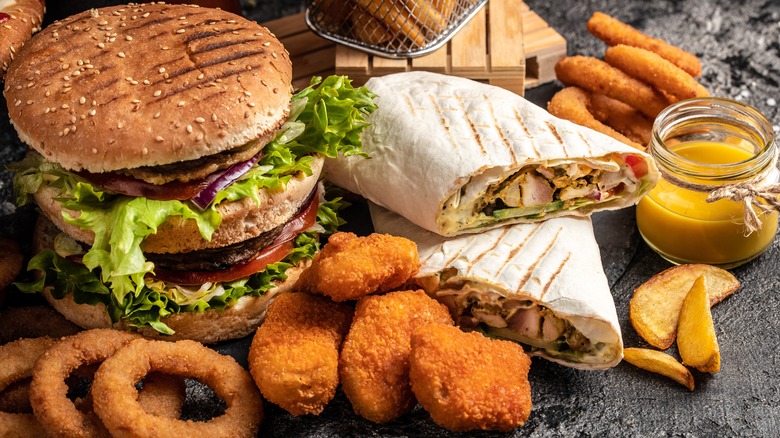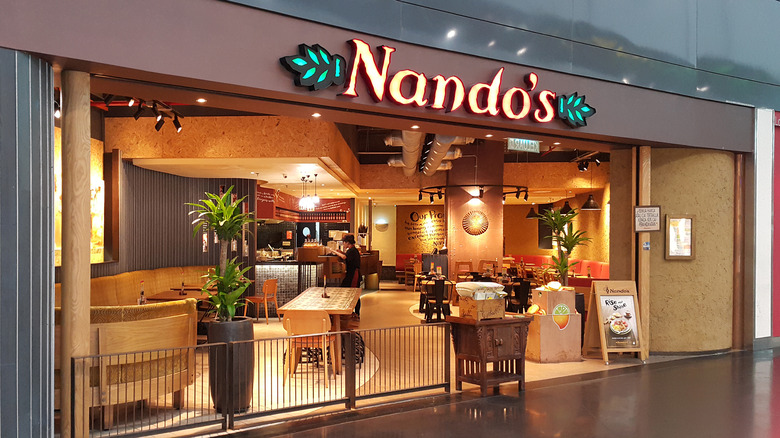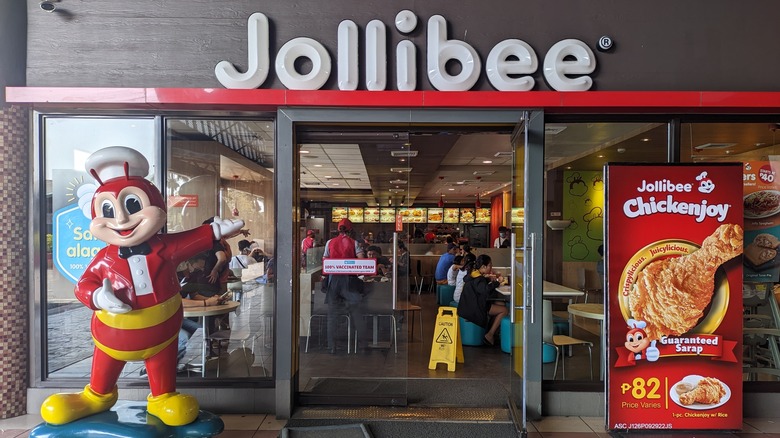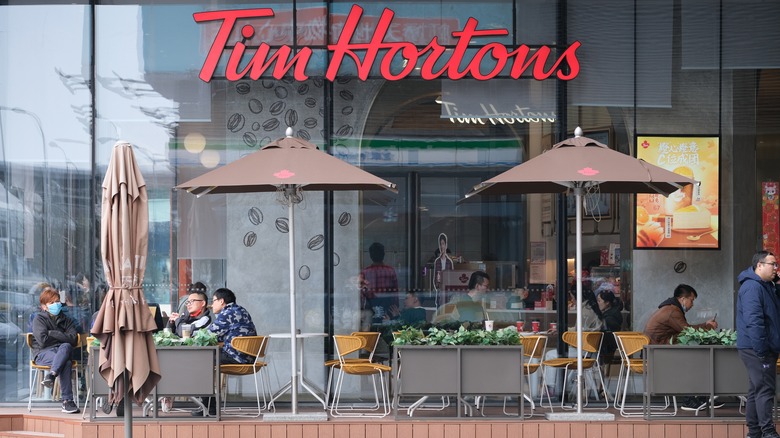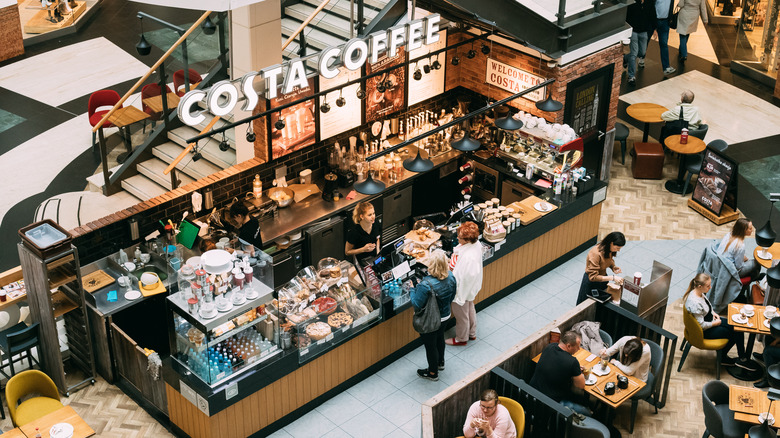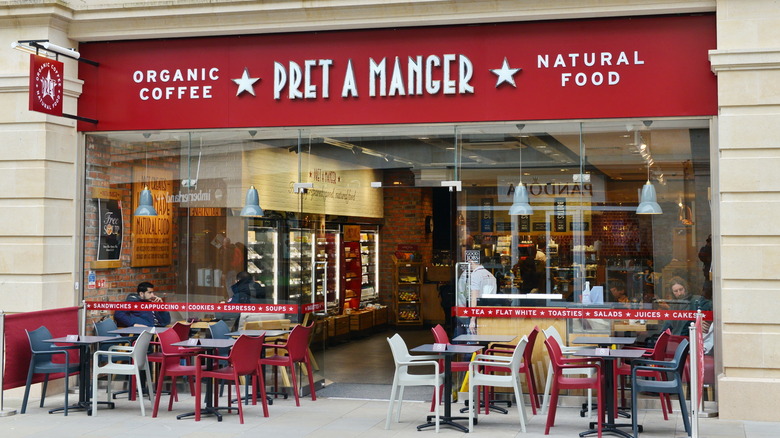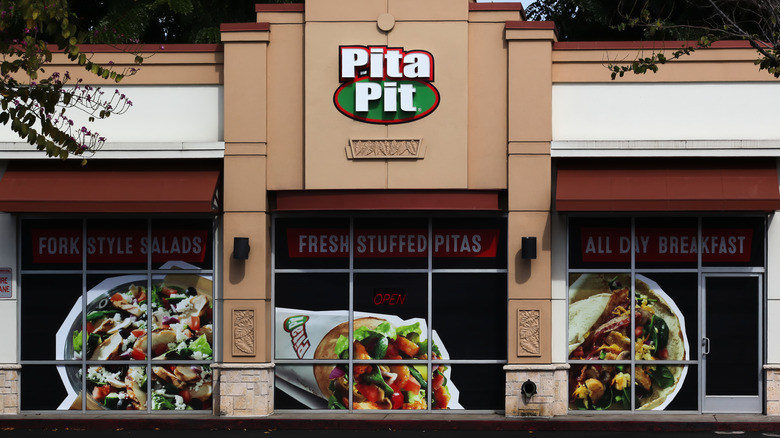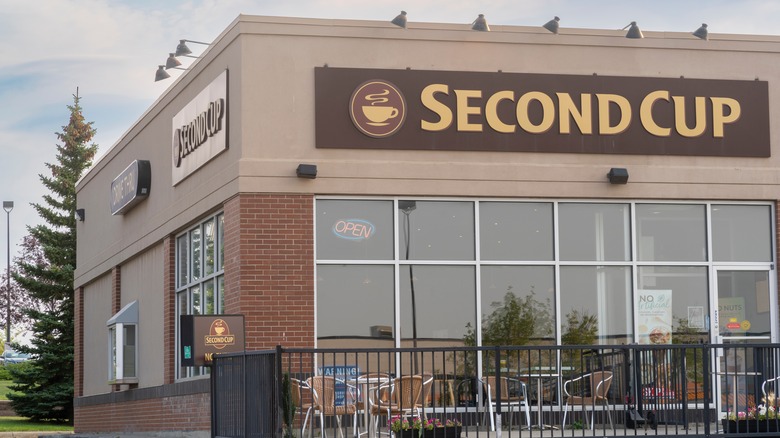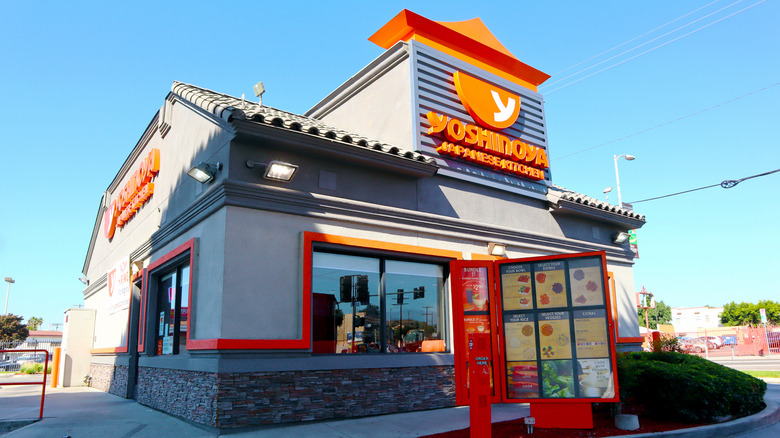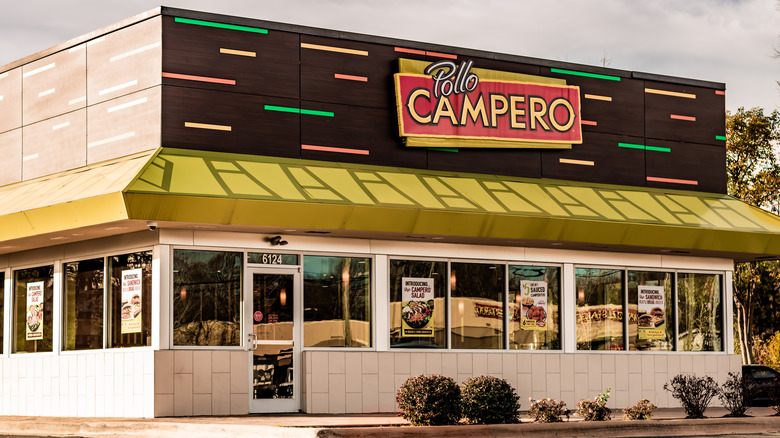Fast Food Chains That Were Surprisingly Started In Other Countries
There's no denying it — some of the world's biggest fast food chains have had their beginnings in the U.S. McDonald's, KFC, and Burger King are just a few such grab-and-go restaurants that over the years have become worldwide powerhouses. However, in recent decades, we have seen an increasing number of fast food chains from other countries expanding their presence not only in the U.S. — but also globally. And the origins of some of these chains might surprise you.
Given the long-standing presence of many international fast-food chains in the States, it's easy to mistake them for U.S. inventions. While some of these well-known pit stops serve American-style fare, others have stayed true to their roots and maintained their unique identity. Regardless of whether they have adapted to American tastes, there's no denying the fact that international fast-food chains have enriched the country's fast-food landscape with their unique offerings.
Nando's
The origins of Nando's can be traced back to 1987 when two friends enjoyed a meal at a Portuguese restaurant in Johannesburg, South Africa. The duo was immediately taken with the eatery's flamed grilled chicken and peri-peri, a spice made with African bird's eye chili, lemon, and garlic. However, unlike most others who would just try to replicate the meal at home, the pair ended up purchasing the entire restaurant.
Within three years of opening, Nando's had three outlets in South Africa and one restaurant in Portugal, the country of origin of one of the restaurant's founders. By 2012, Nando's expanded its reach to over 1,000 stores in countries such as the UK, Canada, Australia, Israel, Namibia, and Zimbabwe. Today, the chain serves its spicy chicken in over 20 countries, including the U.S. where it first opened for business in 2008. Fast forward to 2023, and the chain continues to broaden its U.S. footprint, with more than 40 restaurants in Washington, Virginia, Chicago, and Maryland. And for those craving Nando's secret peri-peri, the restaurant now offers its sauces in takeout bottles. Any royal aficionados can also order to eat just like Prince Harry.
Jollibee
Known for its burgers, fried chicken, and minimalist spaghetti, Jollibee didn't always serve fast food. Instead, the chain started out as an ice cream parlor when Tony Tan Caktiong went into a franchise deal with Magnolia Dairy in 1975. Tan started his empire with two parlors in the capital of The Philippines, Manila. When people started asking Tan for food, he obliged by supplementing his ice cream menu with sandwiches and hamburgers. In 1978, both stores were renamed Jolibe (a predecessor of what would later become Jollibee). The chain's favorite menu items — including yumburger, jolly spaghetti, and chickenjoy fried chicken — were all already on the restaurant's menu by the end of the 80s.
Things moved in leaps and bounds for the chain after it was turned into a franchise in 1979. And Jollibee outlets weren't just doing well in The Philippines. The chain started its global expansion by opening a location in Brunei in 1987. Other countries followed, and today the franchise can be found in more than 20 countries, including the U.S. where the fast-food restaurant first opened its doors in 1998. Standing testament to its popularity, today Jollibee boasts around 70 outlets in America and around 1,300 stores worldwide.
Tim Hortons
Well-known for its coffee, donuts, and other baked goods, Tim Hortons has hundreds of locations across America. Anyone familiar with hockey, however, knows the idea that it originated in the U.S. couldn't be further from the truth.
Tim Horton, who founded his namesake restaurant in Hamilton, Ontario, in 1964, is known to many as a National Hockey League player rather than a businessman. According to The Commons Cafe, Horton charged customers 10 cents per cup of coffee and 69 cents per donut when the store first opened. Three years later, the hockey legend joined forces with Ron Joyce, who took over the reins of the business after Horton passed away in 1974. The Timbits, or small donut balls, which are still sold by the franchise, were created to honor Horton's contribution to the Canadian fast-food industry.
The first U.S. Tim Hortons outlet opened in Tonawanda NY in 1984, and since it was so close to the border, it quickly became a popular destination for quick coffee and snack stops for Canadians. Over the next few decades, the chain thrived, expanding not just in the U.S. but also globally, introducing new menu items such as flavored lattes and Tim Hortons iced capp. Acquired by a Brazilian equity firm, 3G Capital, in 2014, today Tim Hortons boasts over 5,000 outlets across the globe.
Costa Coffee
Italians are famous for their love of quality coffee. As such, it shouldn't come as a surprise that Costa Coffee was founded by Italian brothers, Sergio and Bruno Costa. What many might find surprising, however, is that the popular chain didn't have its start in Italy, or even America, but in central London way back in 1971. Eager to produce some of the finest coffee in the country, the brothers set up a small roastery, where they blind-tested 112 coffee bean samples before selecting Mocha Italia as their signature blend. Interestingly, this custom blend can still be purchased at Costa Coffee cafes.
While the brothers initially distributed their beans to restaurants across London, they decided to take their business to the next level in 1981 by opening the first Costa Coffee outlet. Things progressed quickly, and today the chain is the second-largest coffeehouse franchise in the U.K, with around 3,000 locations (the brand was acquired by Coca-Cola in 2018).
Despite its popularity at home, Costa Coffee didn't open its first store in the U.S. until 2022 when it finally launched an outlet in Atlanta, Georgia. Up to then, the chain used automated Costa Coffee Smart Cafe machines and BaristaBots to sell coffee in America. Another Atlanta, Georgia, store opening followed within months.
Pret A Manger
Translating to "Ready to Eat" in French, Pret A Manger specializes in organic coffee and fresh meals and snacks — as well as vegan options. Despite its name, however, the chain didn't originate in France but in London (the franchise opened its first outlet in France in 2012). The brainchild of two college friends, Julian Metcalfe and Sinclair Beecham, the first Pret A Manger, which opened in 1986, was far from an instant success. In fact, according to The Guardian, the business lost around £80,000 in its first year of operations.
While it took a little time and perseverance, the public gradually warmed up to Pret A Manger's health-centered menu and altruistic conscience — the business gives back to the local community by donating all its unsold fare to welfare organizations. In fact, the chain eventually started doing so well that the powers that be decided to roll it out internationally, with the first Pret A Manger in the U.S. opening in New York in 2000. Today, Pret A Manger operates over 500 stores in countries such as India, Portugal, and Ireland, as well as approximately 80 locations in the U.S.
Pita Pit
If you think Pita Pit got its start in America, think again. The popular Lebanese-inspired food chain is actually a Canadian invention. The first Pita Pit was opened in Ontario, Canada, in 1995 by Nelson Lang and John Sotiriadis. With the motto, "Fresh thinking, healthy eating," the outlet specialized in menu options that are not as high in fat, calories, and carbs as traditional fast food meals. While the first Pita Pit initially sold its wrap-style sandwiches to college students, it wasn't long before more Pita Pit restaurants started opening across Canada and catering to a wider demographic.
Pita Pit's foray into the international market began in 1999, with the launch of an outlet in Syracuse, New York. Today, the franchise has more than 200 locations across the U.S. and nearly 600 outlets worldwide, in such far-flung countries as New Zealand, Australia, and India. So what's the secret to Pita Pit's success? According to Lang, it's the flexibility that the chain gives its franchisees to customize their menus to suit local preferences. "In India, our menu is very different from what it is in North America, much more vegetarian. In New Zealand, we do a lot with New Zealand lamb," he told The Financial Post.
Second Cup
Located in more than a dozen countries – including the U.S. — Second Cup started out as a humble kiosk that served six different coffee blends in a Canadian shopping mall. Fast forward a few decades, and today Second Cup has around 360 stores across Canada, making it the biggest retailer of specialty coffee in the country. And the restaurant's menu has been expanded to offer not only coffee but also a range of smoothies, baked goods, and breakfast options.
Founded in 1975, Second Cup did remarkably well right from the get-go, undergoing fast-paced expansion in the 1980s. By 1989, the coffeehouse chain had expanded its network to around 130 locations, with the majority of them situated in shopping malls and office buildings. And as Second Cup's menu grew, so did its clientele. In 2021, the cafe chain was purchased by Foodtastic, a franchiser with a plan to expand the chain's presence across Canada and farther across the globe.
Yoshinoya
It's easy to mistake Yoshinoya for an American fast-food chain, considering they have been serving beef bowls in the US since 1975. In reality, Yoshinoya originated in Tokyo, Japan where it was founded way back in 1899. When it comes to the company's presence in the States, Yoshinoya USA, Inc. was first established in 1973 to source beef. It wasn't until the U.S. temporarily banned beef exports two years later that the first Yoshinoya restaurant was born. By 1986, Yoshinoya had 20 locations across the States, with this figure reaching 50 in 1991.
In the 90s and 2000s, Yoshinoya focused on both expansion in the U.S. and Asia, setting up shop in countries such as Indonesia, Singapore, China, Thailand, and South Korea. By 2010, there were around 100 Yoshinoya locations in the U.S. and over 600 worldwide. Today, the restaurant boasts over 2,000 outlets globally. And while Yoshinoya's claim to fame has been its signature gyudon beef bowl, today the chain serves over 20 different bowl types including the hugely popular grilled teriyaki chicken.
Pollo Campero
Pollo Campero is all about chicken and more specifically about Latin-American-style fried thighs, breasts, and wings. And even though the fast-food chain has been serving its fried meals in the U.S. since 2002, its story dates back to 1971 Guatemala. Started by the Campero family, Pollo Campero uses an original chicken recipe that has been passed down through generations. And the formula seems to have worked. Even before the fast food restaurant opened its doors in the U.S., Pollo Campero had already gained a following among chicken lovers who returned home from trips to Central America with the restaurant's flavorful chicken meals.
Pollo Campero enjoyed immediate popularity upon its launch in the United States, with the opening of its first restaurant in Los Angeles creating block-long queues. Today, the fast food chain has around 80 locations in Guatemala and close to 300 outlets around the globe. In 2022, the franchise announced its plan to open 250 more locations in the States within a period of four years. Luis Javier Rodas, Pollo Campero's Managing Director and COO, explained the company's ambitious expansion plan to 1851 Franchise, stating, "The whole chicken industry is very hot right now. [...] Customers feel they are eating much healthier when eating chicken versus pizza or a hamburger. Also, they know what they are getting — with other meats, they aren't sure if it is 100% beef or pork."
